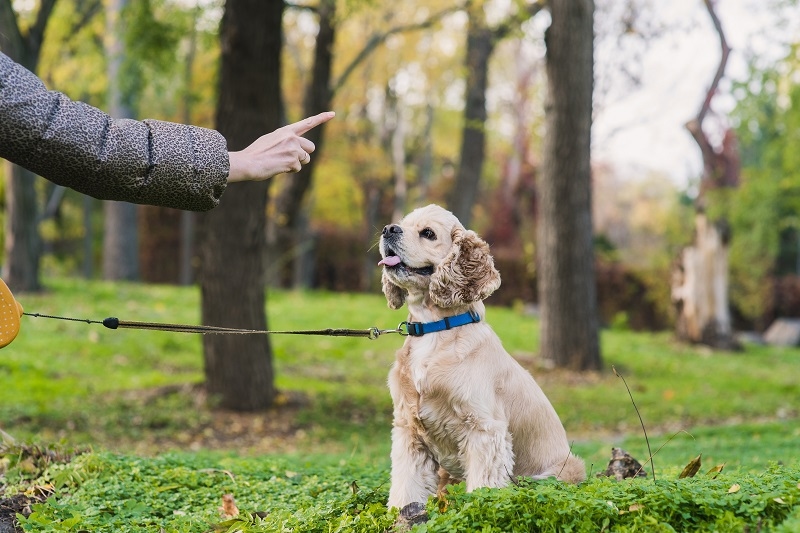
Training a dog can be one of the greatest times in a pet owner's life, but it can also be frustrating when you find that things like basic commands and leash training don't translate. Here, dog training collars—specifically remote ones—can be convenient. Most people refer to remote dog training collars as e-collars, but for the sake of readability, we will use them in both ways throughout this guide. Dog training collars reinforce good behavior, get the dog to follow commands, and add some security/reliability when training your dog off-leash.
When using a safe dog training collar properly, you can use it successfully to enhance communication between you and your dog. A dog training collar is a fun and interactive training aid. While there are countless designs and products at stores and online, finding the best dog training collar for your furry companion can be challenging. This guide will cover what you need to know about dog training collars (and e-collars), what is best for your breeds/needs, etc.
Understanding Remote Dog Training Collars
A remote dog training collar is a tool that generally consists of two parts:
- A collar around a dog's neck has stimulation modes (tone, vibration, or static).
- A handheld remote that the owner uses to communicate with the collar.
It's important to realize that the goal isn't to punish the dog but to communicate with him. For example, when your dog ignores your personality when you tell him to sit, the collar vibrates under his collar and reminds him to refocus and pay attention. With continued use and consistent communication, you will establish manners and some level of successful off-leash control that doesn't require constant pulling on the leash, yelling, or unnecessarily shouting commands over time.
Key Benefits of Remote Dog Training Collars
- Better Communication: Your commands are enforced in real-time, even at a distance.
- Safer off-leash reinforcement: This allows the dog to have complete freedom of exploration, still under your observation.
- Customizable Degree of Intensity: Many collars are adjustable, providing more humane training.
- Effective for Stubborn Dogs: Some dogs require a more concrete reinforcement to listen consistently.
Are remote dog training collars safe?
Many pet owners wonder whether dog training collars are safe. The short answer is yes, when used appropriately. Safe modern dog training collars are geared towards being humane and offer adjustable settings with sound, vibration, or mild static stimulation. The goal is not to elicit pain but to redirect the dog's mindset and discourage unwanted behavior.
As with any training tool, damage can happen if misused, causing undue stress or fear, but e-collar training can be efficient, mainly when used with positive reinforcement.
Factors to Consider Before Buying a Remote Dog Training Collar
With so many different dog training collars available, you should be looking for these various features when buying the right collar:
- Range: Range is vital if you train off-leash in large open spaces; you will want a collar with the biggest range.
- Stimulation Modes: Sound, vibration, and static allow you to train many behaviors.
- Waterproof: Necessary for dogs that love to swim or go outdoors.
- Battery life: Long-lasting rechargeable batteries ensure you can conduct enjoyable training sessions without worrying about the collar dying.
- Fit and Comfort: A collar that fits your dog is essential for safety and effectiveness.
- Durability: Quality materials are essential, as dogs can be physically demanding in their activity.
Top Remote Dog Training Collars for Reliable Behavior Control
Here’s a rundown of the best remote dog training collars that offer safety, durability, and effectiveness.
1. Remote Training Collar for Beginners
- Best for: New dog owners learning e-collar training.
- Features: Simplistic controls, tone/vibration modes, low-level static, short range.
- What Makes It Great: Safe to use, simple to use, and designed for smaller dogs.
2. Professional-Grade E-Collar
- Best for: Experienced trainers or owners of persistent breeds (or both).
- Features: Long-range (up to 1 mile), multiple levels of stimulation, waterproof collar.
- What Makes It Great: Perfect for serious training and off-leash reliability.
3. Budget-Friendly Dog Training Collar
- Best for: Owners who want reliable training tools at an affordable price.
- Features: Basic tone, vibration, and static modes, moderate range.
- What Makes It Great: It has the basic features you need at a price that doesn't break the bank.
4. Multi-Dog Training Collar
- Best for: Households that have more than one dog.
- Features: Single remote that connects with multiple collars independently.
- What Makes It Great: Train two or more dogs simultaneously without confusion.
5. Remote Collar with Comfort Features
- Best for: Dogs with sensitive necks (small dogs).
- Features: Lightweight, padded contact points, adjustable straps.
- What Makes It Great: Comfort-oriented while still being practical.
How to Use a Remote Dog Training Collar Responsibly
The best dog training collar will only be good with the person using it. Follow these recommendations to help you achieve positive results while not bringing stress to your dog:
- Always start with the lowest setting: introduce tone or vibration, not static shock.
- Be Sure to Introduce Verbal Commands: Say the command first, then correct with the collar for reinforcement.
- Reward good behavior: Combine collar cues with praise or treats to encourage learning.
- Do not overuse the collar: use it only when necessary; don't use it for every command.
- Practice in short training sessions with your dog: Be sure to have hands-on training for under 15 minutes during the collar training period.

E-Collar Training for Off-Leash Freedom
Many dog owners' primary reason for getting a remote dog training collar is the desire for safe off-leash dog training. They dream of hiking, camping, or going to the park without worrying about their dog running off.
When properly trained with an e-collar, dogs learn to respond to commands when distractions are intense. This makes outdoor adventures safer and more enjoyable for both dog and owner.
Alternatives to Remote Dog Training Collars
While e-collar training is practical, some owners prefer to explore alternatives. Here are a few:
- Clicker Training: Uses sound as a favorable reinforcement.
- Harness Training: Offers control without neck pressure.
- Head Collars: A gentle option for leash-pulling issues.
- Reward-Based Systems: Relies solely on treats and praise.
Each method has pros and cons, but many owners find that a combination of tools works best.
Tips for Choosing the Best Dog Training Collar for Your Pet
When you select your options, please consider your dog's breed, size, temperament, and what you hope to accomplish with training. For example:
- Small breeds may need lightweight collars with gentle settings.
- Working dogs may need a more extended range and more durability.
- Stubborn dog types may work better with higher stimulation settings on their collar.
Building a Training Routine with Your Dog
A remote dog training collar can only be a piece of the puzzle. Having an ongoing program with a well-organized training schedule will yield better results. Here is an easy-to-follow plan:
- Define the Goals: Determine if the training focus will be recall, stopping barking, or leash manners.
- Indoor Beginnings: Start training in a location with no distractions.
- Add Distractions: Gradually move to the outdoors once the commands are consistent.
- Have Consistency: Use the same commands and signals every time.
- Training vs. Play: Training sessions should be perceived as positive sessions; training sessions can be enjoyable and rewarding.
The Future of Dog Training Collars
As technology advances, remote collars are becoming more intelligent and more humane. Future designs are expected to include:
- GPS tracking features for safety during off-leash adventures.
- Mobile app integration for monitoring progress.
- Improved comfort designs for better wearability.
- More humane alternatives focus on vibration and sound over static.
You May Check Out: Cut Costs on Pet Sitting: Get Rover Coupons
Final Thoughts
A remote dog training collar can make a huge difference for you as a new or seasoned dog owner. If used correctly, dog training collars can allow owners to communicate clearly, build trust, and help keep off-leash dog training both safe and fun for dog owners and their dogs.
As we talked about earlier, the intention of obtaining the best dog training collar is not to control your dog alone by fear but to control their behaviors reliably through consistency and positive reinforcement. Correctly using one of the best collars on a well-constructed training plan will alleviate unwanted behaviors and strengthen the bond and relationship with your four-legged friend.


































































-1683797766-r.jpg)











-1681135791-r.jpg)


